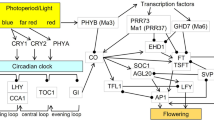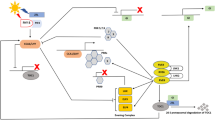Abstract
Sugarcane genetic improvement is hampered by the inconsistent flowering of clones. This not only limits choice of parents but also restricts the ability to transfer new traits including GM traits. Further, it is believed to be easier to generate transgenic plants from callus derived from plants induced to flower. Consequently, being able to induce flowering at will would have multiple benefits including improved conventional breeding, production of GM varieties and the transfer of new traits, including GM events, into a range of backgrounds. Additional benefits would be derived from reducing the 12 months growing period normally needed for sugarcane to reach maturity and flower. Floral induction in sugarcane, like most flowering plants, is dependent upon external (photoperiod, temperature, etc.) and internal factors (hormones, circadian rhythm, etc.). While successful photoperiod procedures have resulted in flowering in 70 % of the stalks and 90 % of cultivars tested, a number do not respond to this induction. Furthermore, published reports suggest that, without a ‘persistent pressure’ during the floral development process, sugarcane will revert back to vegetative growth. The reasons behind this lack of floral induction are unknown but important to research if ‘floral induction on demand’ is to be successful. Understanding the genes involved in the floral pathway and their expression during floral development will assist with identifying key points to manipulate to ensure flowering. The genetic resources available in model plants, such as Arabidopsis, maize and rice, have allowed definition of the roles and importance of inflorescence development genes, thus determining points of control in the flowering pathway. These resources provide a place to start when examining the sugarcane flowering pathway. This review presents a synthesis of results of floral induction/reversion in the literature and suggests a likely path for genetic control of sugarcane flower development.

Similar content being viewed by others
References
Berding, N., and P.H. Moore. 2001. Advancing from opportunistic sexual recombination in sugarcane: Lessons from tropical photoperiodic research. Proceedings of the International Society of Sugar Cane Technologists 24: 482–487.
Berding, N., R.S. Pendrigh, and V. Dunne. 2007. Can flowering in sugarcane be optimised by use of differential declinations for the initiation and development phases? Proceedings of the International Society of Sugar Cane Technologists 26: 699–711.
Berding, N., R.S. Pendrigh, and V. Dunne. 2010. Pursuing higher efficacy for managed photoperiodic initiation of sugarcane flowering in the tropics. Sugarcane International 32 (5): 234–250.
Brunkhorst, M.J. 2001. A preliminary investigation into the effect of plant nutrient levels on sugarcane flowering. Proceedings of the Annual Congress—South Africian Sugar Technologists’ Association 75: 143–150.
Brunkhorst, M.J. 2003. Investigation into the flowering of sugarcane variety N29 grown under different nutrient regimes. Proceedings of the Annual Congress—South Africian Sugar Technologists’ Assocation 77: 306–312.
Burr, G.O., C.E. Hartt, H.W. Brodie, T. Tanimoto, H.P. Kortschak, D. Takahashi, F.M. Ashton, and R.E. Coleman. 1957. The sugarcane plant. Annual Reviews Plant Physiology 8: 275–308.
Clements, H.F. 1975. Flowering of sugarcane: Mechanics and control. Technical Buletin Hawaii Agricultural Experiment Station 92: 1–56.
Clements, H.F., and M. Awada. 1965. Experiments of the artificial induction of flowering in sugarcane. Proceedings of the International Society of Sugar Cane Technologists 12: 795–812.
Coleman, R.E. 1963. Effect of temperature on flowering in sugarcane. International Sugar Journal 65: 351–353.
Coleman, R.E. 1968. Physiology of flowering in sugarcane. Proceedings of the International Society of Sugar Cane Technologists 13: 992–1000.
Davies, W., and A. Vlitos. 1967. Some aspects of flowering in sugarcane and its relationship to sucrose metabolism: Cellular and molecular aspects of floral induction. Proceedings of a Symposium 31:462–471.
Fornara, F., A. de Montaigu, and G. Coupland. 2010. SnapShot: Control of flowering in Arabidopsis. Cell 141 (3): 550.
George, E.F., and J.A. Lalauette. 1962. Photoperiodic experiments in the sugar cane variety Cp. 36-13. Proceedings of the International Society of Sugar Cane Technologists 11: 516–527.
Gosnell, J.M. 1973. Some factors affecting flowering in sugarcane. Proceedings of the Annual Congress—South Africian Sugar Technologists’ Association 47: 144–147.
James, N.I., and J.D. Miller. 1971. Shoot apex development in early-, mid- and late-season flowering sugarcane clones. Proceedings of the International Society of Sugar Cane Technologists 14: 334–340.
Julien, M.H.R. 1971. The photoperiodic control of flowering in Saccharum. Proceedings of the International Society of Sugar Cane Technologists 14: 323–333.
Julien, M.H.R. 1973. Physiology of flowering in Saccharum. Journal of Experimental Botany 24 (3): 549–557.
MacColl, D. 1977. Some aspects of the flowering of sugar cane in barbados and its control in a breeding programme. Annals of Botany 41 (1): 191–201.
McSteen, P., D. Laudencia-Chingcuanco, and J. Colasanti. 2000. A floret by any other name: Control of meristem identity in maize. Trends in Plant Science 5 (2): 61–66.
Moore, P.H. 1971. Investigations of the flowering of Saccharum. I. Ontogeny of the inflorescence. Canadian Journal of Botany 49: 677–682.
Moore, P.H., and K. Nuss. 1987. Flowering and flower synchronization: Developments in crop science 11: Sugarcane improvement through breeding, 273–311. New York: Elsevier.
Paliatseas, E.D., and S.J.P. Chilton. 1956. The induction of the emergence of the inflorescence of sugarcane. Proceedings of the International Society of Sugar Cane Technologists 9: 657–664.
Paterson, A.H., J.E. Bowers, R. Bruggmann, I. Dubchak, and J. Grimwood. 2009. The Sorghum bicolor genome and the diversification of grasses. Nature 457 (7229): 551–556.
Pereira, A.R., V. Barbieri, and N.A. Villa Nova. 1983. Climatic conditioning of flowering induction in sugarcane. Agricultural Meteorology 29: 103–110.
Shanmugavadivu, R., and P. Gururaja Rao. 2009. A comparison of flowering behaviour of sugarcane clones in two different locations. Sugarcane Technology 11 (4): 401–404.
Vettore, A.L., F.R. da Silva, E.L. Kemper, and P. Arruda. 2001. The libraries that made SUCEST. Genetics and Molecular Biology 24 (1–4): 1–7.
Acknowledgments
The authors would like to thank NRC Research Press for permission to reproduce photographs from Moore, P.H. (1971). Investigations of the flowering of Saccharum. I. Ontogeny of the inflorescence. Can J Bot 49: 677–682 ©Canadian Science Publishing or its licensors. Reproduced with permission. We would also like to thank Miles M Hakoda (Director of Office of Communication Services, University of Hawaii at Manoa) for permission to reproduce images from Clements (1975). Finally we would like to thank Dr DM Hogarth for permission to reproduce photographs and images from ISSCT papers.
Author information
Authors and Affiliations
Corresponding author
Rights and permissions
About this article
Cite this article
Glassop, D., Rae, A.L. & Bonnett, G.D. Sugarcane Flowering Genes and Pathways in Relation to Vegetative Regression. Sugar Tech 16, 235–240 (2014). https://doi.org/10.1007/s12355-013-0284-z
Received:
Accepted:
Published:
Issue Date:
DOI: https://doi.org/10.1007/s12355-013-0284-z




